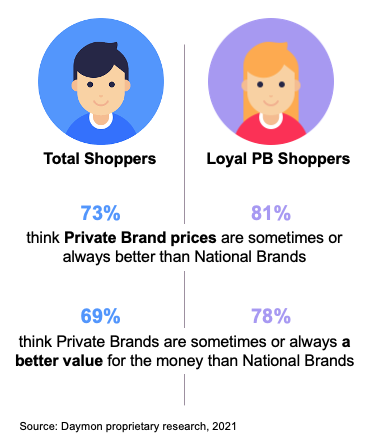What is the purpose of a Private Brand program? While Private Brands were originally positioned as generic items of low cost and quality, this legacy perception is no longer the reality. Today’s Private Brands have evolved into brands in their own right, and serve to provide more than just low-price options within a retailer’s portfolio.
As consumers give Private Brands permission to evolve, the industry as a whole is continuously moving forward. Major retailers have realized the potential for Private Brands to drive differentiation, purchase, and loyalty and are investing in their programs. These programs are consumer-centric, with ongoing marketing and merchandising support, as part of the overall corporate pillars. Similarly, independent retailers must think bigger about the role of Private Brands in their stores to drive four crucial benefits.

The first key benefit of Private Brands is to offer low prices. While this is no longer the sole advantage of Private Brands, this is still a key consideration factor for consumers – especially in today’s landscape with increasing grocery prices and inflation. According to Daymon’s research, 53% of consumers cite saving money as a big influence in their brand selection; they also think Private Brands are sometimes or always a better price and value than National Brands. To fully deliver on this proposition requires expanding this role to be inclusive of value overall, rather than simply the lowest price point; multiple quality tiers should be leveraged to deliver various definitions of value to different consumer groups.
The second key benefit of Private Brands is to grow the total business. While Private Brands capture revenue and margin from sales of those items, a strong program will have a secondary impact as well. At the category level, categories at independents such as dessert toppings, frozen vegetables, bath & shower, and lunch meat are seeing total category growth where Private Brand growth is outpacing that of National Brands. At the store level, Daymon’s research shows that loyal Private Brand shoppers spend more of their dollars at that retailer; Daymon’s analysis also shows that 75% of independent retailers who grew Private Brand share also grew market share.

The third key benefit of Private Brands is to stem leakage. Most competitors’ assortments are the same, with up to 98% overlap between their items; Private Brands help to create distinction and differentiation to drive consumer store choice. Consider a brand in the lifestyle tier such as Clearly by Best Choice. These individual items may not be the largest sales contributors in a given category, but serve additional purposes, such as retaining the total basket of a consumer who would otherwise need to find the offering at a competitor. On average, three-quarters of leaked dollars are spent at major retailers, not other independent banners, indicating that this expanded differentiation is required.
Finally, Private Brands also provide the benefit of building for the future. Consumers give Private Brands credit for critical aspects of the brand experience beyond price alone. According to Daymon’s research, 76% of consumers have an overall positive image of Private Brands; 86% think the quality of Private Brands is as good as or better than National Brands, and 89% trust Private Brands just as much if not more than National Brands. This permission to evolve into consumer-centric brand positionings allows Private Brands to expand into new items, categories, and tiers to deliver on these consumer needs in new ways both today and tomorrow.





